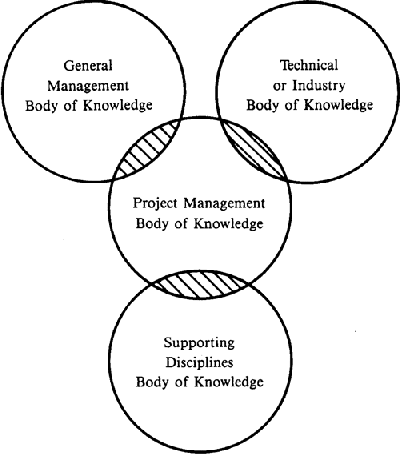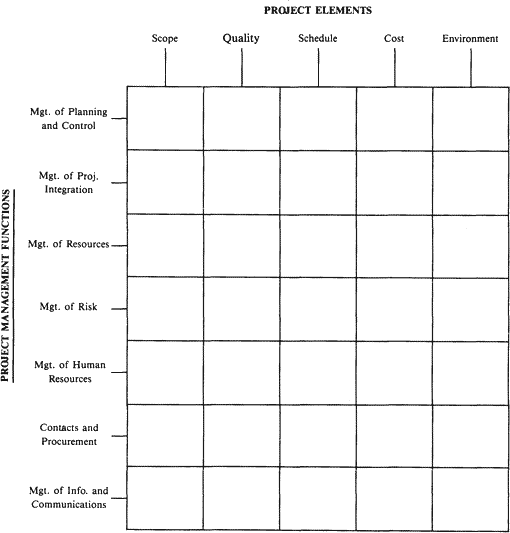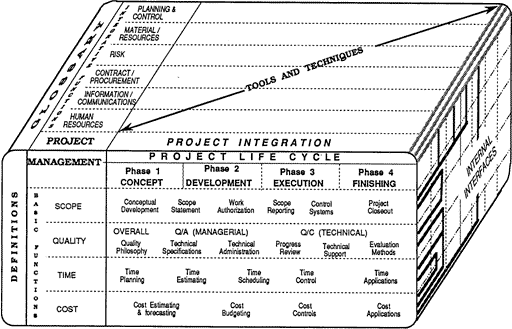Project Management Models in the Late Eighties
With the publication of the Project Management Institute's Project Management Body of Knowledge ("PMBOK") in 1987, there were several attempts to illustrate the nature of project management as shown by the following Figures 4, 5, 7 and 8.[15]
Figure 4: Project management body of knowledge setting
The 1987 PMBOK document describes Figure 4 as follows:
"It is possible to depict the environment of project management and its related body of knowledge in a number of different ways. Venn diagrams [as shown in Figure 5 below] and three dimensional matrices or boxes [as shown in Figures 6 and 7 below] are all feasible. Figure [4 above] attempts to show the role of the PMBOK as a vehicle for creation of change between General Management and Technical Management. The explanation of the diagram is as follows:
The light gray background represents abstract space. Into this space is introduced the top strip which is intended to portray the whole spectrum of knowledge which is required to successfully conduct industry and business. Of course this includes both the public and private sectors. As the diagram shows, this spectrum ranges from the know-how of general management on the left, through project management, to technical management on the right.
The next series of strips immediately below are intended to elaborate on the top strip. The central overlay circle encompasses the four key constraints of scope, cost, time and quality. As every project manager knows, these restraints are inextricable intertwined. Scope-quality represents performance, scope-cost represents viability, cost-time represents effort, and quality-time represents competitiveness."[16]
 Figure 5:The scope of the project management body of knowledge
In the discussion of Figure 5, the 1987 PMBOK document observes that there is a definite need for overlaps in the various bodies of knowledge as indicated in the figure. That is, project managers and their teams have a great need for an expertise in general management as well as considerable knowledge and expertise in the particular technology of the project. The supporting PMBOK text describes some of the relevant subject areas.
The 1987 PMBOK committee felt that the fundamental building blocks of project management were the three basic project management functions or elements of every project, namely schedule, cost and technical performance presented as a triangle. Interestingly, this "basic" triangle was adopted by Professor H. Kerzner as the motif for the cover jacket of his book "Project Management: A Systems Approach to Planning, scheduling and Controlling" as shown in Figure 6.[17]
Figure 6: Kerzner's cover jacket
Given the fundamental building blocks (of Figure 6), the PMBOK committee of the day felt that the simplest format was to portray the essential characteristics of every project in three dimensions as shown in Figure 7.
Figure 7: A three dimensional matrix
There was little argument about the "Project Life Cycle" but the relationship between the other two was more problematic. This resulted in the enlarged matrix as shown in Figure 8 that was considered a more flexible and useful framework on which to build.[18]

Figure 8: Project management matrix model
By 1988, members of the Project Management Institute's "PMBOK Committee" felt that these illustrations were inadequate given "the difficulties involved in creating a comprehensive yet concise, universal yet specifically applicable document defining the domain of a new profession."[19] Professor Alan Stretton was therefore asked to prepare a critique. To summarize his findings, Stretton came up with a "Three-Dimensional Core PMBOK Framework Model" sometimes referred to as the "Suitcase" (of project management tools and techniques) as shown in Figure 9. The text accompanying the illustration described the model in detail and was further elaborated in Dinsmore's 1993 Handbook of Project Management.[20] Stretton pointed to a number of shortcomings in the original PMBOK and made several recommendations for consistency. However, the Institute appears to have abandoned this course in favor of producing "A Guide to the Project Management Body of Knowledge".

Figure 9: Stretton's suitcase of project manager's tools and techniques
(Note: This illustration is a subsequent elaboration,
as the type size in the original is too small for display in this media.)
15. Project Management Body of Knowledge, Project Management Institute, PA, 1987, pages 1-5, 2-3, 2-4, 2-5 respectively.
16. Ibid, pages 1-4, 1-5
17. Kerzner, H., Project Management: A systems Approach to Planning, Scheduling and Controlling, Van Nostrant Reinhold, NY, 1989, cover jacket.
18. Ibid, page 2-5
19. Editor's Note to A Consolidation of the PMBOK Framework and Functional Components by A. Stretton, Project Management Journal, Vol XX, Project Management Institute, 1989, p5.
20. Stretton, A. M., Developing a Project Management Body of Knowledge, Chapter 3 in The AMA Handbook of Project Management, Editor Paul C. Dinsmore, AMACOM, 1993, p32.
|



